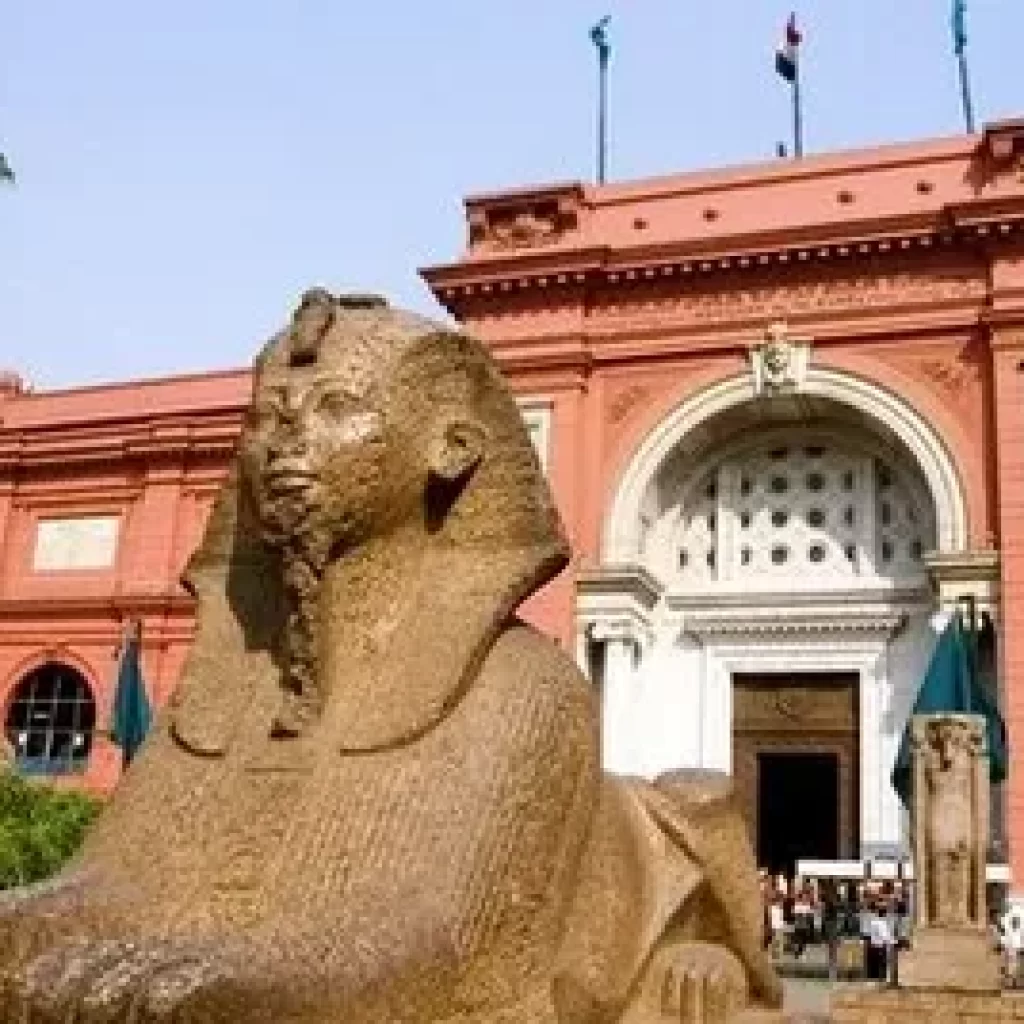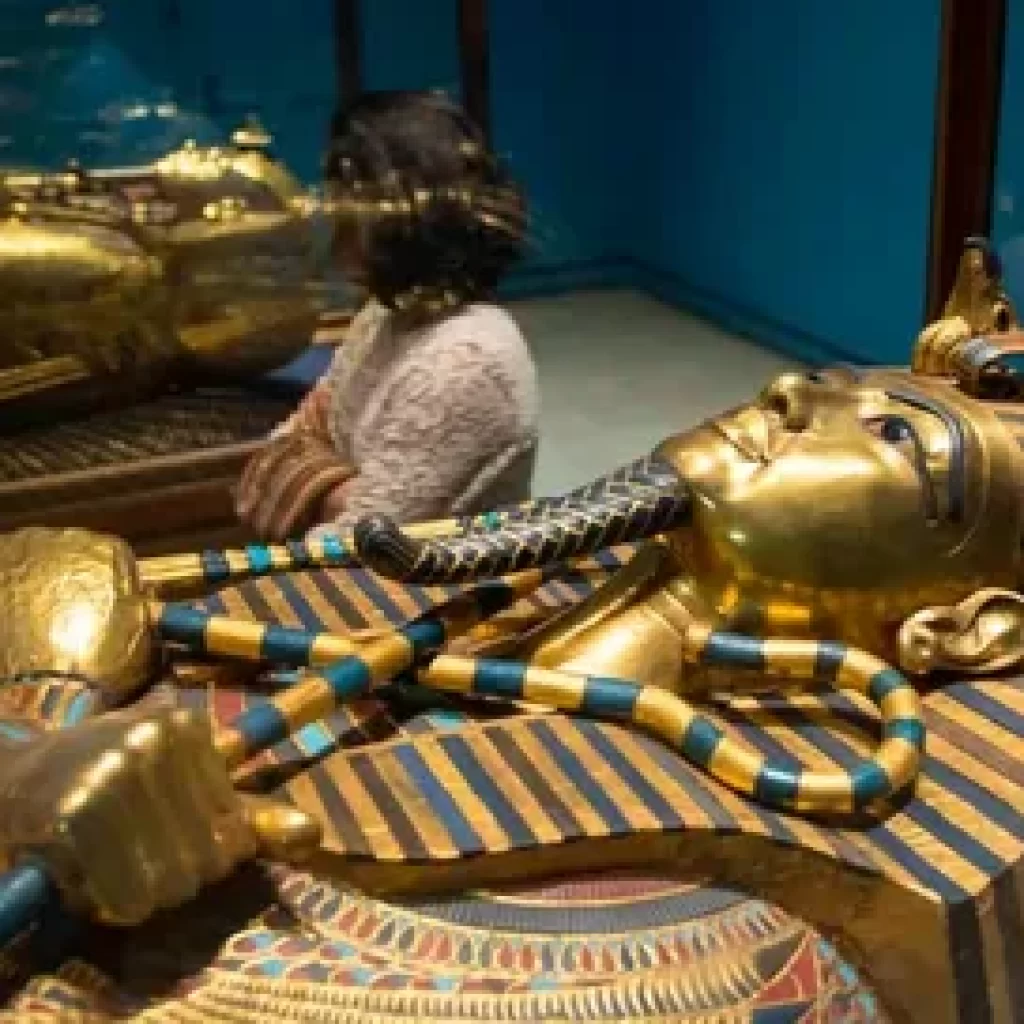Table of Contents: El Cairo Museum
- Introduction
- A Glimpse into the History of the Cairo Museum
- The Magnificent Architecture of the Cairo Museum
- The Iconic Collections of the Cairo Museum
- The Enigmatic Tutankhamun’s Treasures
- Exploring Ancient Egyptian Artifacts
- The Royal Mummies Hall: A Glimpse into the Afterlife
- The Rosetta Stone: Decoding Ancient Hieroglyphs
- Unravelling the Secrets of the Cairo Museum’s Tombs
- Modern Amenities and Visitor Experience
- Conclusion
- (FAQs)

Introduction: El Cairo Museum
El Cairo Museum, Welcome to the Egyptian Museum, located in Cairo, Egypt, which houses the largest collection of Egyptian antiquities in the world. Located in a building built in 1901, it is the largest museum in Africa. The entrance fee is 200 Egyptian Pounds, or about $6.50. A video ticket, which I purchased, costs 450 Egyptian Pounds El Cairo museum.

- A Glimpse into the History of El Cairo Museum:
El Cairo museum, has two floors and is rectangular in shape with a large hall at the center. We will walk through the first floor, entering every room, and then move on to the second floor at time 1:24:41. This room contains artifacts from the Predynastic (6000 – 3000 BC) to Early Dynastic (2920 – 2544 BC).

- The Magnificent Architecture of the Cairo Museum:
Discover the architectural marvel that is the Cairo Museum, with its grand façade, impressive halls, and purpose-built galleries designed to showcase the treasures of ancient Egypt.
- The Iconic Collections of the Cairo Museum:
This is the Narmer Palette, which dates to around 3100 BC and is carved out of a dark gray-green siltstone. The palette contains some of the earliest hieroglyphic inscriptions ever found and has been considered “the first historical document in the world”. To our left is a strange and unique object known as the Disc of Sabu, or Tri-Lobed Disc, which was found in the tomb of Prince Sabu in 1936.
This strange disc was carved out of rock! Prince Sabu’s tomb is dated to circa 3,000 BC, making the disc at least 5,000 years old!

- The Enigmatic Tutankhamun’s Treasures:
Many believe the disc was part of some kind of mechanism while others think it was simply a decorative bowl or vase. It is also believed that this is a stone reproduction of an even earlier disc made out of metal.
The reason for its existence remains a mystery to this day, but the museum display claims it is a “vase, of unique form, intended to be mounted on a post, and possibly intended to hold lotus flowers.” The artefacts in the Central Hall come from the Middle Kingdom (1980 – 1760 BC) to the New Kingdom (1539 – 1077 BC).
- Exploring Ancient Egyptian Artifacts:
Here is there the pyramidion of Amendment III, the capstone that once crowned the Black Pyramid at Dasher, Egypt. It was discovered in 1900 partially buried in the sand next to the pyramid. The capstone was carved out of basalt around 1850 BC…nearly 4,000 years before it was found in the sand. These sarcophagi are stone containers that each hold another coffin, typically made out of wood.
(08:18) Very few pyramids (pyramid capstones) have survived into modern times.

- The Royal Mummies Hall: A Glimpse into the Afterlife:
The Egyptian Museum was first established in 1835. The objects moved from one location to the next over the next several decades until they were moved here to Tahrir Square in 1901. A new Grand Egyptian Museum has been under construction for the last several years and is nearly complete. It is set to open in November 2023.
The new museum’s construction cost is estimated at $1.03 billion and is set to be the largest archaeological museum in the world. The new museum is located near the Great Pyramid in Giza. Hopefully, the artefacts in the new museum will have labels and descriptions. Most of the artefacts this museum do not.

- The Rosetta Stone: Decoding Ancient Hieroglyphs:
At the far end of the hall is the Colossal statue of Amenhotep III and Tiye. The statue dates back to 1360 BC and originally stood in Medinet Habu, Western Thebes. The statue belonged to the mortuary temple of Amenhotep III, which has been mostly destroyed since, but during its time was the largest temple complex in Thebes, surpassing even the Karnak temple.
- Unraveling the Secrets of the Cairo Museum’s Tombs:
As it was built too close to the floodplain, less than two hundred years later it already stood in ruins and most of its stones were reused by later pharaohs for their own building projects This is a small room between the Central Hall and the outer hallway that leads around the museum. This is a statue group of Ramses 2 between the goddesses Isis and Hathor, made from granite.

- Modern Amenities and Visitor Experience:
The Department of Antiquities operated a sale room in the Egyptian Museum in Cairo starting in1902 in room 56 on the ground floor. Original ancient Egyptian artworks and other original artefacts were sold in that room. In addition, until the 1970s, dealers or collectors could bring antiquities to the Cairo Museum for inspection on Thursdays.
- Conclusion:El Cairo museum
The last “great” pharaoh from the New Kingdom is widely considered to be Ramesses III, a Twentieth Dynasty pharaoh who reigned several decades after Ramesses II. This granite sphinx is a portrait of Hatshepsut with the elegant feminine features of all her statues. It was one of several that once stood at Hatshepsut’s mortuary temple.
Sphinx statues continued to be produced throughout ancient Egyptian history and were popular during the New Kingdom. Six colossal granite sphinx statues, in various degrees of preservation, are believed to have originated from Hatshepsut’s mortuary temple at Deir el-Bahari. This is the painted limestone head of Queen Hatshepsut, from one of the twenty-four colossal Osiris statues that decorate the portico of the third terrace of her mortuary temple at Deir el Bahari.

FAQs:El cairo museum
- What are the opening hours of the Cairo Museum?
- The Cairo Museum is typically open from [Opening hours].
- Can I take photographs inside the museum?
- Photography is generally allowed in most areas of the museum, but flash and tripod usage may be restricted.
- Are there guided tours available at the Cairo Museum?
- Yes, guided tours are available at the Cairo Museum, offering insightful commentary and a deeper understanding of the exhibits.
- How long does it take to explore the entire museum?
- The time required to explore the entire museum can vary, but a visit of a few hours is recommended to fully appreciate the collections.
- Is there an entrance fee for the Cairo Museum?
- Yes, there is an entrance fee to visit the Cairo Museum. Prices may vary for different visitor categories.
- Are there any restrictions on touching the artefacts?
- For preservation purposes, touching the artefacts is generally not allowed. Visitors are encouraged to admire them from a respectful distance.
- Is the Cairo Museum accessible to individuals with disabilities?
- Efforts have been made to make the Cairo Museum accessible, but some areas may have limited accessibility. It’s advisable to check with the museum beforehand for specific requirements.





Comment (0)